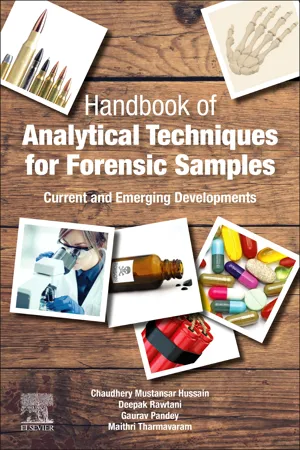
Handbook of Analytical Techniques for Forensic Samples
Current and Emerging Developments
- 452 pages
- English
- ePUB (mobile friendly)
- Available on iOS & Android
Handbook of Analytical Techniques for Forensic Samples
Current and Emerging Developments
About This Book
Handbook of Analytical Techniques for Forensic Samples: Current and Emerging Developments discusses in detail the current trends and latest analytical techniques and methods commonly employed in forensic analysis in order to ensure the proper facilitation of justice. This book is useful for readers who wish to stay updated on the latest trends in the forensic analysis of samples encountered at crime scenes. Technological advancements, such as biosensors, nanotechnology, and taggant technology have upped the level of analysis in forensic science. These emergent technologies, incorporated with existing analytical techniques, are leading to more precise, accurate, and specific examination of forensic samples. Lab-on-a-chip technology has also eased several kinds of on-site analyses done by investigating teams at different types of crime scenes. This book covers the evolution of forensic sample analysis as well as these emerging trends and new technologies.
- Includes an entire section of experimental exercises for self-teaching and key concept review
- Covers laboratory protocols used in forensic science laboratories for the analysis of various samples through different analytical techniques
- Condenses the many aspects of forensic analytical chemistry into a single resource with easy-to-understand language for everyone from students to practitioners
Frequently asked questions
Information
Table of contents
- Cover image
- Title page
- Table of Contents
- Copyright
- Dedication
- Preface
- Chapter 1: Introduction to chemical analysis of forensic samples
- Chapter 2: Forensic sampling and sample preparation techniques
- Chapter 3: UV-visible and fluorescence spectroscopy for forensic samples
- Chapter 4: FTIR and NIR spectroscopy in forensic science
- Chapter 5: Atomic absorption and emission spectrometry in forensic analysis
- Chapter 6: NMR spectroscopy for forensic samples
- Chapter 7: Raman spectroscopy in forensic science
- Chapter 8: HPLC for the toxicological analysis of forensic samples
- Chapter 9: Gas chromatography in forensic science
- Chapter 10: HPTLC in forensic science
- Chapter 11: Hyphenated techniques for forensic sample analysis
- Chapter 12: Optical microscopy for forensic samples
- Chapter 13: Electron microscopy for forensic samples
- Chapter 14: Atomic force microscopy for forensic samples
- Chapter 15: Energy dispersive X-ray (EDX) coupled microscopy in forensic science
- Chapter 16: Mass spectrometry in forensic chemistry
- Chapter 17: X-ray diffraction for forensic samples
- Chapter 18: Lab-on-chip devices
- Chapter 19: Nanotechnology in forensic science
- Chapter 20: Ethics and legal issues of forensic analysis techniques
- Chapter 21: Accreditations for forensic science laboratories
- Chapter 22: Quality control and quality assurance in forensic science laboratories
- Chapter 23: Concluding notes
- Exercise 1: UV-visible spectroscopic analysis of forensic samples (chemical and biological)
- Exercise 2: Fluorescence spectroscopic analysis of forensic samples (biological)
- Exercise 3: FTIR analysis of forensic samples (chemical, physical, and biological)
- Exercise 4: NIR spectroscopic analysis of forensic samples (chemical and biological)
- Exercise 5: Atomic absorption spectrometric analysis of forensic samples (chemical and biological)
- Exercise 6: Optical microscopic analysis of physical and biological forensic samples
- Exercise 7: SEM analysis of physical and biological forensic samples
- Exercise 8: TEM analysis of physical and biological forensic samples
- Exercise 9: AFM analysis of physical and biological forensic samples
- Exercise 10: Mass spectrometric analysis of forensic samples (chemical and biological)
- Index